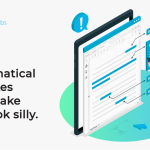So, everything is going swimmingly with your e-commerce store.
Slick website design? Check.
High-quality products? Check.
Eye-catching branding? Check.
Good to go, right? Well, you might be forgetting something.
Product page copy is often tragically overlooked by ecommerce sites. And this is a critical error.
A dry and uninteresting product description can instantly deter a customer from making a purchase, costing you valuable sales and future business.
The job isn’t finished once a customer reaches the product page.
In fact, this is a crucial moment to highlight key product benefits, stir up positive emotions, and secure conversions.
Your product copy needs to be super sharp and expertly refined to increase sales.
How do you achieve this?
Simple. Just follow these 10 tips for crafting high-converting product page copy, complete with product description examples.
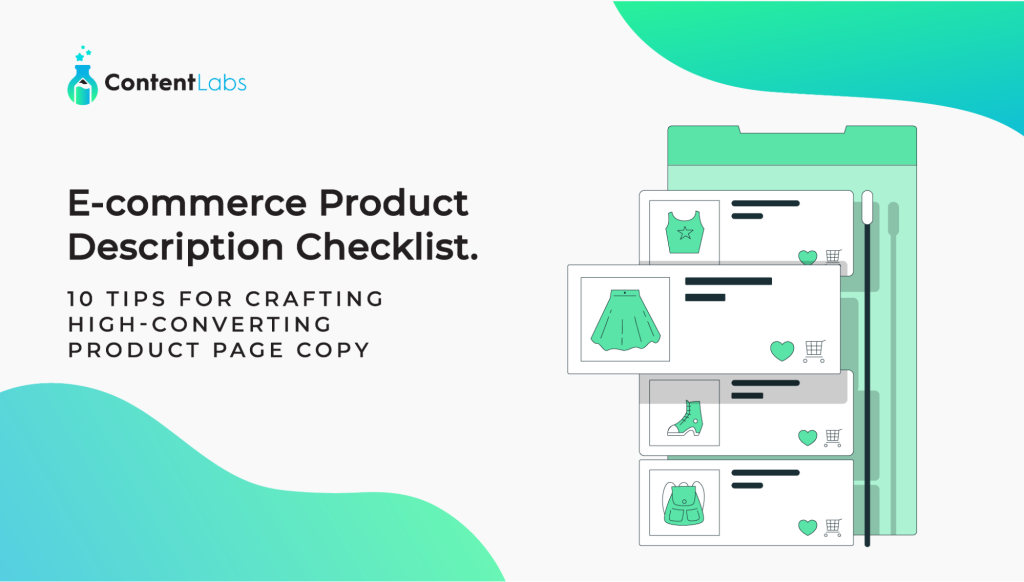
Why is product page copy so important?
Your products are the lifeblood of your online business.
So it’s no wonder that product descriptions are incredibly important.
There are a huge number of touchpoints that can lead to a customer discovering your products. They might click on paid ads, visit your landing page, or scroll through your social feeds.
Product page copy is your final opportunity to persuade a prospect to convert.
It’s the perfect opportunity to remove any barriers that could be in the way of a purchase and reiterate why a customer should proceed to the checkout page.
How can I enhance my product descriptions?
Optimising and improving your product descriptions might sound a little complicated.
In reality, it usually involves simplifying your existing content rather than making it more complex.
Punchy and focused product descriptions are often the most effective when you’re looking to increase online sales.
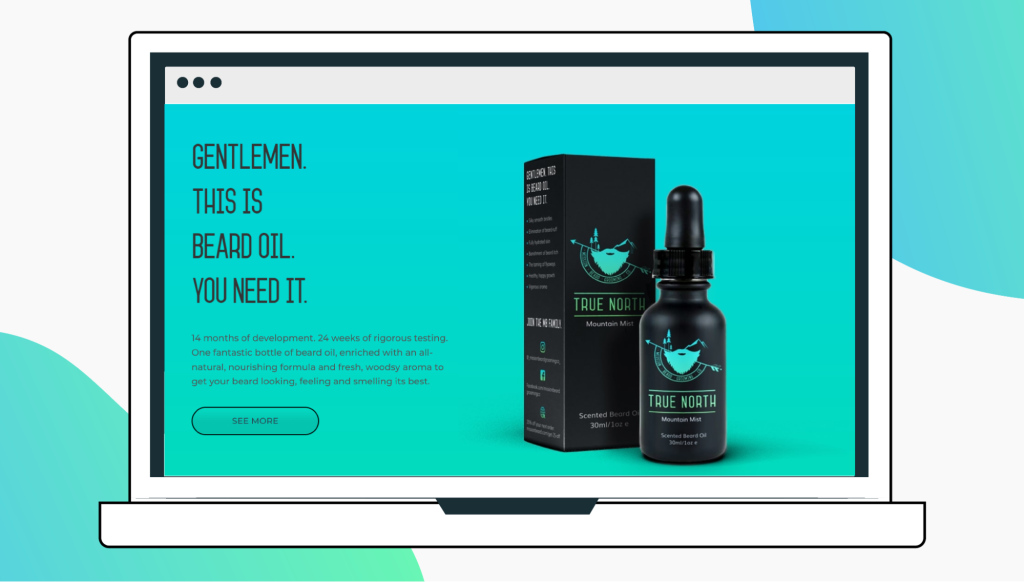
Writing product descriptions is all about drilling down to key selling points, pre-empting customer objections, and persuading prospects to make a purchase.
If you stick to proven strategies while constructing your product descriptions, you’re infinitely more likely to drive sales and increase long-term customer value.
So how can you transform ineffective product descriptions into sales-driving gold?
Let’s dive into 10 tips for product description copywriting that can supercharge your performance and make your products irresistible.
Product page tip 1. Focus on your target audience
To make sure that your product descriptions resonate with your target audience, you need to put yourself in the shoes of a brand new customer.
If you write generic marketing copy that doesn’t feel tailored to your ideal buyers, you’re missing a big opportunity to increase sales.
Product features and benefits only become persuasive when they’re connected directly to your target buyer and their individual needs.
Keep this in mind when you begin writing product descriptions.
- Who is your ideal customer?
- What is a specific pain point they’re dealing with?
- What are their aspirations or goals?
- How does your product enhance their lives?
If you can resolve these questions within your product description template, you’ll give yourself the best chance of skyrocketing your conversions.
A thorough understanding of your target audience is key.
If you need to run audience surveys or request user feedback to build a clearer picture of your buyers, then don’t hesitate to do so!
Where possible, you should also refer to the reader as ‘you’. This is a small tweak, but one that helps to create a more personalised tone that appeals directly to customers.
Below is a great product description example from Union Coffee, advertising its subscription coffee service:
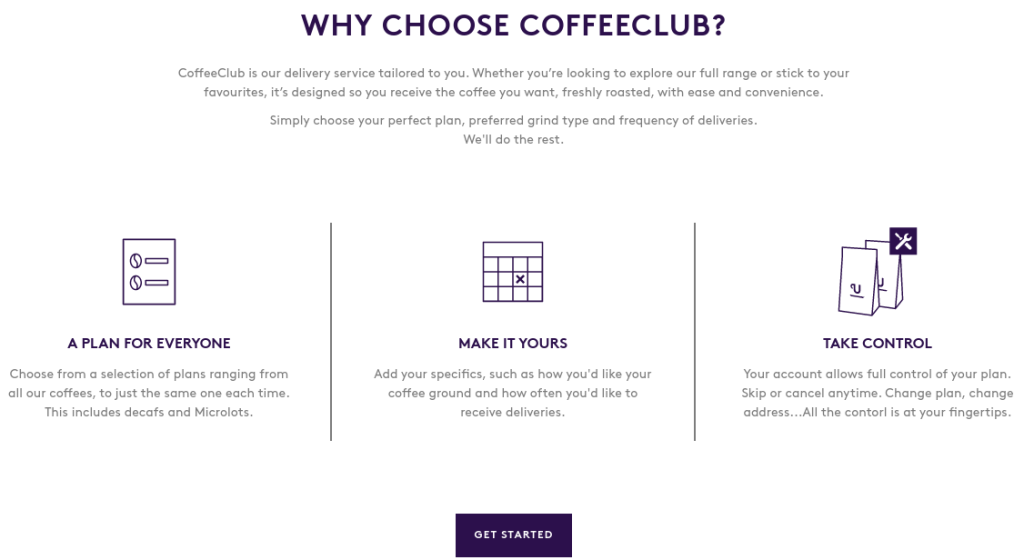
The copy addresses the main features that potential subscribers are likely to be interested in – a wide selection of products, a flexible subscription plan, and a transparent service.
The content doesn’t ramble on about irrelevant features or product specifications. It gets to the point and is clearly tailored to a specific audience.
The copy also constantly refers to the customer as ‘you’, instantly establishing a strong sense of personalisation.
Product page tip 2. Showcase benefits, not just features
Here’s an error that’s incredibly common among e-commerce businesses.
When you’re pulling together product descriptions, it’s tempting to pack in as many technical details as possible about every feature.
You might assume that listing extensive features is a good way to persuade new customers to make a purchase. In reality, this approach can have the opposite effect.
Plain product details are functional, and not necessarily interesting or engaging.
To craft epic product descriptions, you need to transform these functional features into breathtaking benefits.
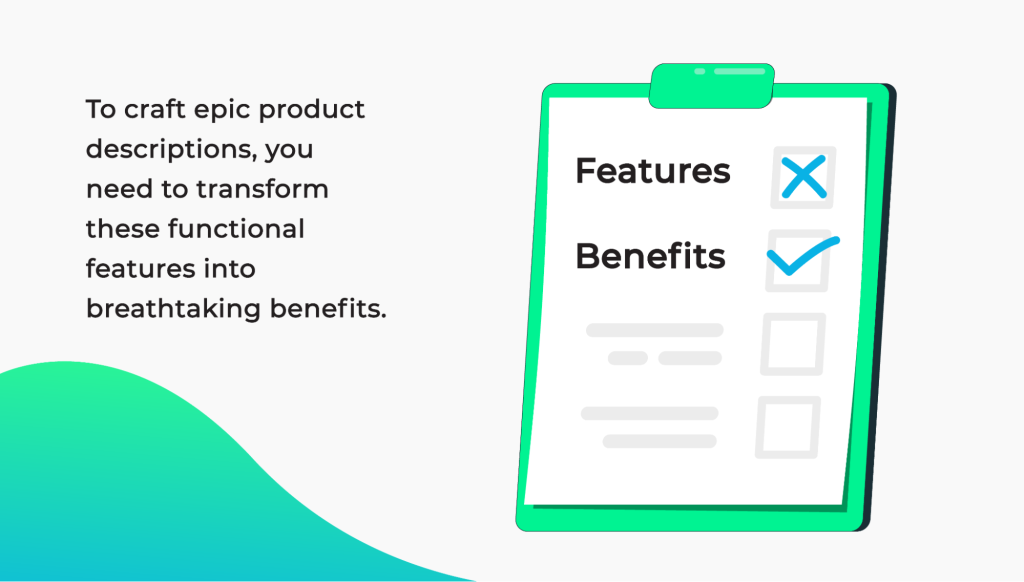
If you can demonstrate how your products can benefit users and improve their everyday lives, you’ll instantly create a more compelling offering.
Don’t just state a product feature. Describe a product benefit.
A big part of this process is understanding your target audience.
If you truly understand how your products can help users, you can start to identify key benefits and remove mundane features from your marketing copy.
When you’re thinking about the key bullet points to mention on a product page, fewer and better is the way forward.
It’s also a good idea to scope out the competition when you’re trying to refine your product benefits. If your online business offers a unique benefit that other brands can’t, you’re onto a winner.
Here’s a strong example from Harry’s, describing the key benefits of its shaving razor:
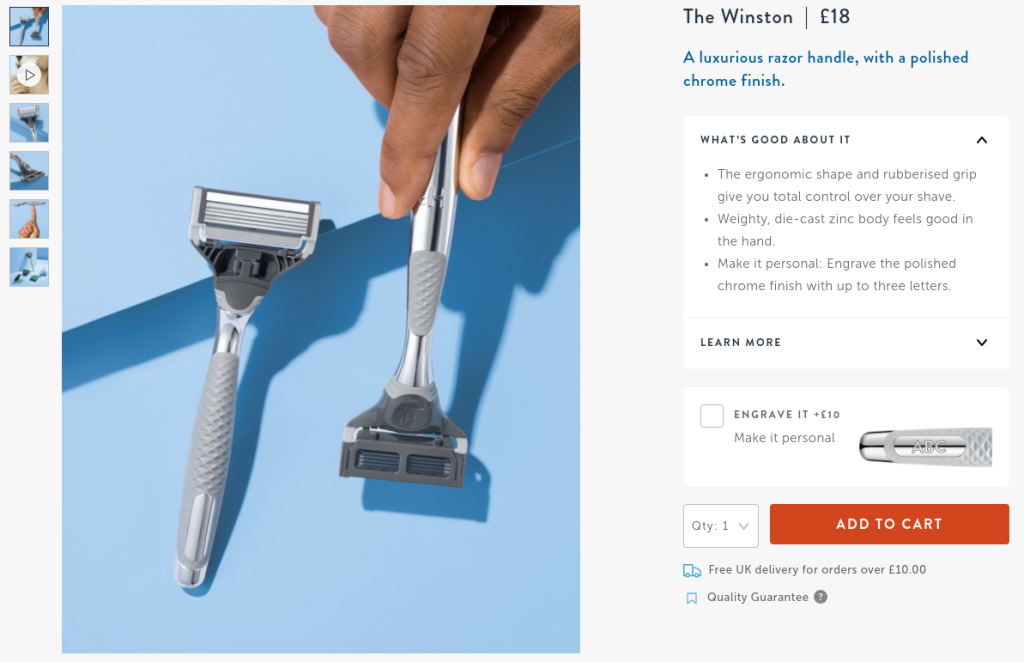
The technical product features are masterfully converted into user benefits.
The razor doesn’t just have a rubberised grip. It has a rubberised grip that gives customers total control over their shave.
The razor handle isn’t just made from zinc. It has a zinc body that feels supremely comfortable for users to hold.
Just remember – product features are functional. Product benefits are persuasive.
Product page tip 3. Maintain a consistent tone-of-voice
Whenever you write product descriptions for your business, imagine that you’re communicating directly with a potential customer.
Maintaining a consistent brand voice across your messaging is key, and this is particularly important on your product pages.
Think about it. If someone changed their accent, tone, or language every time they spoke to you, it would be a little confusing, right?
The same applies to your ecommerce site copy.
Product pages are often neglected, and more effort is usually invested in the landing page content and headlines.
If a customer clicks on a charismatic landing page headline and ends up on a dry and boring product page, they’re probably going to feel a little disappointed.
Make sure that your brand’s tone is consistent with the rest of your communications when you write product descriptions.
If you’re humorous on your landing pages, stay humorous on your product pages. If you’re slick and professional on your social feed, stay slick and professional on your product pages.
By establishing a strong and recognisable tone of voice that carries over to your product descriptions, you’re more likely to stand out among your competitors.
Plus, a consistent tone makes everything feel more cohesive and connected across the customer journey. A brand that feels reliable and familiar is more likely to inspire confidence, which is more likely to result in conversions.
Here’s a solid example of a consistent brand tone of voice from Eve mattresses:
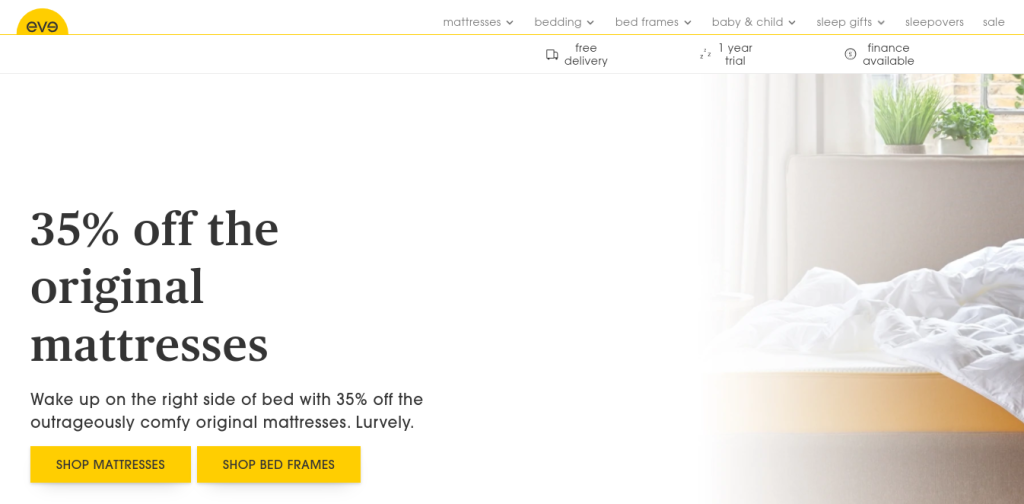

The landing page immediately sets up a clear tone of voice for Eve.
It’s friendly and casual, using informal phrases like ‘comfy’ and ‘lurvely’ to establish personality.
The product page mirrors this style. Certain words like ‘nifty’ and ‘lug’ maintain the casual language, and this warm tone is expertly combined with key product benefits.
The result? A product page that feels aligned with the Eve brand, consistent across the online store, and trustworthy for new buyers. That’s a formula for a successful sale.
Product page tip 4. Pack your pages with social proof

There might not be a single ‘silver bullet’ that can instantly optimise your product pages.
But social proof is pretty close.
Incorporating social proof into your product descriptions is a surefire way to consistently increase conversions over time.
So what is social proof, exactly? Well, it’s content that helps to boost the credibility of your business, enhance your reputation, and persuade customers to buy.
Social proof can appear in many different forms, including:
- Customer reviews
- Business ratings
- Trust badges
- Client logos
- User Generated Content
- Influencer content
Whatever the content, it all comes down to strengthening your business credentials when you write product descriptions.
As humans, we like to trust businesses before we hand over our hard-earned cash to them.
If we see other people vouching for services or products, this makes them seem more trustworthy.
Social proof can have an immediate impact on product page performance.
By leveraging social proof when you write product descriptions, you instantly give prospects a compelling reason to buy your products and believe in your product quality.
Social proof is also easy to integrate into your product descriptions. It could be a glowing customer review in a headline, or an industry award mentioned in your body copy.
These little additions can have a seriously big impact on your revenue.
The more you utilise social proof in your product pages, the more sales you drive.
More sales equal more happy customers, which generates more valuable social proof.
You get the idea.
Here’s a smart example of social proof in action from SquareSpace:
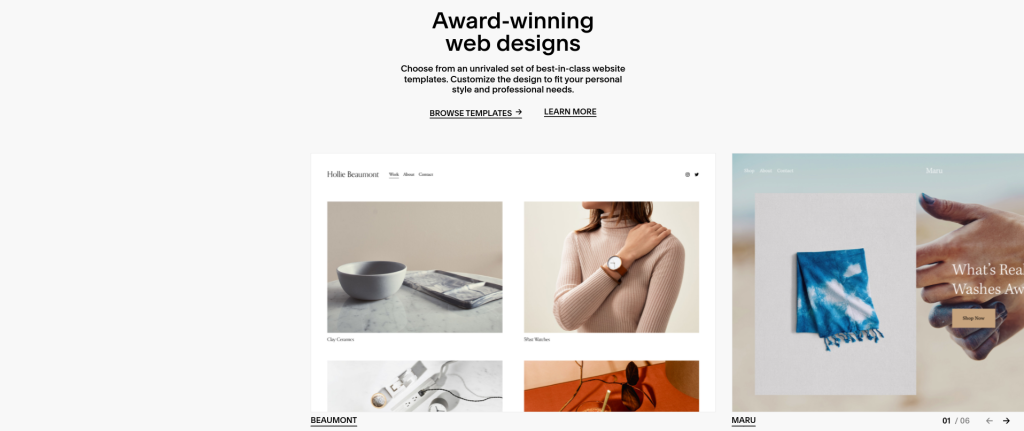

Social proof is naturally integrated into the product page copy here.
The phrase ‘award-winning’ instantly adds credibility to the SquareSpace offering, while the customer review neatly summarises the product benefits.
These are subtle additions to the product page, but they are some of the most impactful elements of the copy.
Product page tip 5. Fuel your copy with search engine data
Search Engine Optimization is key to increasing the visibility of your brand in organic search rankings.
Appearing more frequently within relevant search results is an excellent way to drive more traffic to your online store and improve your conversion rate.
Luckily, your product descriptions can help to enhance your SEO performance.
By incorporating some SEO best practices into your product descriptions, you can make your product pages even more valuable, and visible in search engines.
The first thing to focus on is a clear keyword strategy.
Find an effective keyword tool that can help you to understand search volumes in your category and identify keyword opportunities.
Once you’ve got a better idea of the SEO landscape in your industry, you can start to pack your product page copy with relevant keywords. You’ll likely need a balance of broader keywords and more niche terms that help you to get ahead of the competition.
However, it’s also important to use your keywords strategically in a detailed description.
Nobody is going to be persuaded by a clunky product page that’s been stuffed with keywords for Search Engine Optimization purposes.
Instead, place keywords tactically throughout your copy. Include these terms sparingly in page URLs, product titles and body copy to keep things balanced.
It’s about juggling functionality with readability. You should also constantly conduct SEO research to make sure that you’re keeping up with new trends and relevant keywords.
Here’s a good example of tactical product page SEO from FeelUnique:

The FeelUnique ecommerce site ranks highly in search engines for a ‘skincare travel kit’ search, and when you check out its product page copy, it’s clear why.
The copy is brimming with relevant keywords (e.g. travel sets, beauty travel kits, travel bag sets) which are guaranteed to boost performance in search engines.
However, crucially, the copy still reads well and does an excellent job of describing the product range in an appealing way.
Product page tip 6. Spark your audience’s imagination
There are undoubtedly a lot of technical elements and tactics behind an effective product page.
Keyword placement, intuitive design and smart formatting are all fundamental to building product pages that work for your business.
But it’s vitally important to maintain creative flair while you’re writing product descriptions and creating a product title.
Your product descriptions need to capture the imagination of your customers if they’re going to ramp up your online sales.
A well-designed product page isn’t much use if the content is bland and uninteresting.
You need to stir up positive emotions and generate excitement to succeed.
Make potential customers feel like they’re holding or using your products. Use copy to describe how the product works, how it feels, and how it can benefit buyers.
Utilise power words and engaging language to bring your product benefits to life.
Product photos are important to include within these pages, but your copy also needs to spark imagination.
To write product descriptions that sell, consider what your customers are hoping to receive from a purchase, and tailor your content accordingly.
Let’s say that you’re selling kitchen utensils. Customers are probably looking for practical products that can make life easier for them in the kitchen.
If you just describe these products with functional words and boring phrases, your copy won’t have much impact.
However, if you describe how these utensils will help your customers to ‘effortlessly create culinary magic’ and ‘transform their cooking routine’, you’ll capture their imagination.
And that’s infinitely more likely to drive a click.
Here’s a great product page from MADE.com that uses power words to stir up positive emotions:

These persuasive product descriptions are full of graphic and evocative language.
Customers are guaranteed to ‘enjoy the feeling of plush material’ under their toes, while their new rug brings a ‘calming feel’ to their home.
This language isn’t overdone here, but it’s used sparingly to bring functional products to life and help readers imagine how they’ll relish their new purchase.
And if a customer is fully convinced that they’ll enjoy a product, they’re more likely to buy it.
Product page tip 7. Anticipate a buyer’s questions
When potential buyers land on your product pages, they’re probably going to have a few questions in mind.
- How does this product work?
- What are the best features?
- Who is this product designed for?
By pre-empting these questions and tackling them in your product descriptions, you can stay ahead of the curve.
Answering these queries makes customers feel more confident in their purchase decision, which will encourage more conversions.
Try to anticipate some basic questions that a customer might have about your specific products.
Which main features are prospects probably searching for? Do they need to be educated about how to use a product? Is the price point a major consideration in this market?
Once you’ve ironed out some of the fundamental questions, make sure that they’re answered quickly and efficiently when you write product descriptions.
The answers should be scannable and immediately obvious.
Plus, if your products are cheaper than the competition, or superior in a noticeable way, don’t hesitate to call this out. This is one of the first questions customers will ask, so if you can provide the answer for them, it saves them time and effort.
If you’re struggling to predict customer questions, don’t panic.
Think about common product queries. If a question is regularly appearing in your inbox or chatbox, why not cover it on your product page? You could even send out customer surveys to gather relevant information if necessary.
Below is an excellent example from Peloton, where common questions are addressed throughout the product description template:

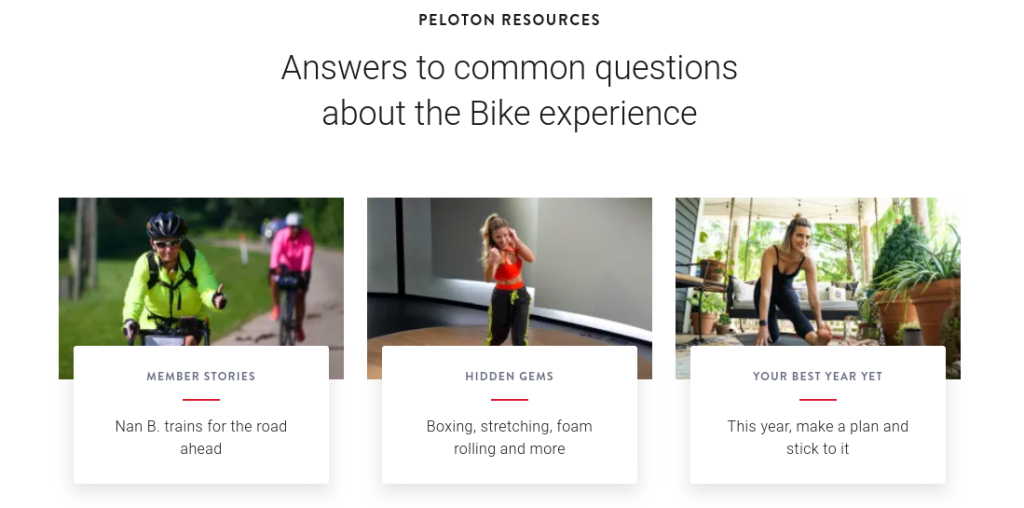
Since Peloton has a unique product offering, basic questions are probably very common among first-time buyers.
The product page is designed to answer questions quickly, explaining:
- How users can access classes 24/7 while using the bike
- The number of classes available to users from home
- How exercise and performance metrics are tracked
- The benefits of the All-Access membership
Plus, a dedicated section for ‘common questions’ is included at the bottom of the page.
When a new buyer lands on these product pages, they’re unlikely to leave with many unanswered questions, which is great for removing barriers to purchase.
Product page tip 8. Include a clear and compelling CTA
Here’s a simple (but fundamentally important) feature to concentrate on when writing product descriptions that sell.
Your primary Call To Action can make the difference between a new customer and an abandoned browser tab.
Page titles, headlines, body copy, good images – all these are important elements to consider, but without a strong CTA in place, they won’t be able to generate results.
Luckily, crafting a compelling CTA isn’t rocket science.
Just ensure that your CTA is visibly signposted, clearly written, and relevant to the action you’d like customers to take.
That’s pretty much it. Simple, right?
The CTA is the ultimate stage before checkout. Prospects have visited your online store, explored your range, absorbed product information, and just need a final nudge to convert.
Here’s a simple but highly effective use of CTAs from Loaf furniture:
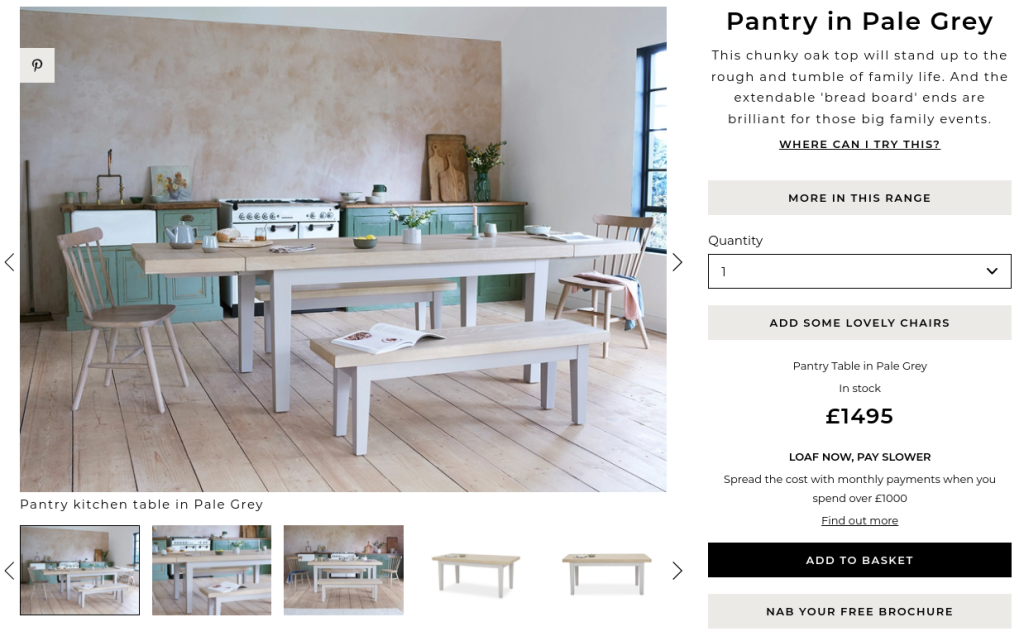
Loaf manages to include multiple helpful CTAs on this product page without the design becoming confusing.
Users have a few options to choose from if they’re not 100% ready to commit. They can explore the Loaf range further, add additional items, or download a brochure.
But if they are prepared to buy, the ‘Add To Basket’ CTA is clearly highlighted.
Plus, this is a great example of brand personality filtering into copy that can often be neglected. Notice how phrases like ‘lovely chairs’ and ‘nab your free brochure’ inject some charm and charisma into a functional CTA button?
This instantly differentiates Loaf from competitors.
Product page tip 9. Use storytelling to capture attention
Depending on your category, it can often feel difficult to create engaging copy that brings your products to life.
Some products lend themselves naturally to exciting and creative copy, while others take a little bit more work.
If you’re struggling to conjure up scintillating product descriptions that sell, storytelling can be a valuable tool.
By incorporating storytelling into your product pages, you instantly generate more intrigue and excitement around your products.
Storytelling allows you to highlight product benefits, add a human touch to your copy, and captivate potential customers.
Storytelling can be used in various different ways.
You might craft a compelling story around the creation of your brand or products, and demonstrate how your ecommerce business has grown over the years.
Or maybe you’ll explain how your products have helped customers in different situations to overcome challenges and enhance their lives.
Whatever the direction you decide, the power of storytelling can help you to capture attention and build excitement around your products.
Here’s a brilliant example of product storytelling from Hiut Denim:

Hiut Denim uses captivating storytelling to highlight various business benefits and strengths.
After reading this short paragraph, users will know that Hiut is focused on creating high-quality denim that’s durable and designed to last.
Strong product benefits, delivered in a highly engaging way. It doesn’t get much better.
Product page tip 10. Craft scannable copy
Here’s an incredibly simple tip that will immediately enhance your product page copy.
Ready for it?
Keep things short and sweet. That’s it.
Write clear and concise copy that’s easily scannable by users.
(See how easy it was to read the above? That’s the power of scannable copy.)
Customers won’t be interested in reading huge chunks of text, and many of them will be clicking between pages and tabs in a hurry.
Don’t bog users down in technical details and product specifications.
Stick to your key product benefits, deliver them succinctly, and ensure that the most important information (e.g. the product title) is available at a glance.
Bullet points can be a very handy tool to utilise here.
Below is a shining example of super-scannable product descriptions from Dollar Shave Club:

This page perfectly balances key product information with short and snappy copy.
Users can easily scan the bullet points and familiarise themselves with the product offering, which helps them to make a quick purchase decision.
No need for lengthy blocks of text.
Just streamlined product description writing that gets the job done.
Creating high-converting product page copy doesn’t need to be a painful process.
All you need to do is follow a few simple best practices to master product description writing.
Take all of these pointers on board, and you’ll be left with exceptionally effective product copy that grabs attention, drives clicks and increases revenue.
Need high-quality content for your business? Create your free account now.
